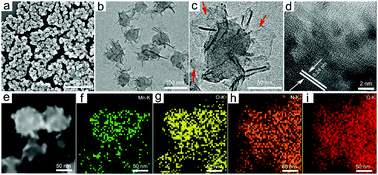The controllable growth of ultrathin MnO2 on polydopamine nanospheres as a single nanoplatform for the MRI-guided synergistic therapy of tumors†
Abstract
The integration of two-dimensional (2D) nanosheets with biocompatible photothermal nanoparticles may produce effective multifunctional nanotheranostic agents. However, such explorations are hindered due to the lack of suitable methods for the incorporation of both materials. In this work, a simple redox strategy was designed for the controllable growth of ultrathin manganese dioxide nanosheets on polydopamine nanospheres. After loading with methylene blue, the obtained polydopamine@ultrathin manganese dioxide/methylene blue nanoflowers (termed PDA@ut-MnO2/MB NFs) show excellent multiple capabilities for tumor synergistic therapy, for instance: (1) they efficiently modulate the tumor microenvironment (TME) via the generation of O2 and the depletion of glutathione (GSH); (2) they demonstrate favorable photothermal effects during PTT to speed up intratumoral blood flow and chemical reactions, enhancing oxygen distribution and synergistically increasing PDT efficacy; and (3) they support ultrasensitive reduction-responsive magnetic resonance imaging (MRI). Using mice bearing HCT116 colorectal tumors as a model system, PDA@MnO2/MB NFs were shown to achieve near-complete suppression of tumor growth following MRI-guided PDT/PTT synergistic therapy.

- This article is part of the themed collection: 2019 Journal of Materials Chemistry B HOT Papers


 Please wait while we load your content...
Please wait while we load your content...